Monthly Diary 2014
Monthly Diary 2014
December 2014
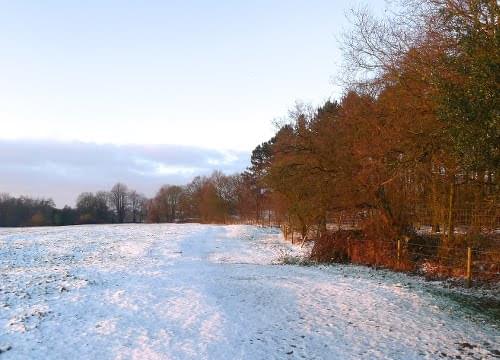
A very short post this month! We finish off the year with a very wintery feel, with the snow lying on the ground and the the early morning sun catching the trees, to give them a lovely golden tinge.
We have also continued to monitor the foxes on the Green and have managed to get some more interesting footage. This can be seen on Georgia's blog and there are two clips (under Christmas foxes). The second clip is very interesting and shows one of the foxes displaying some dominant behaviour to the other fox. To me this is what makes using trail cameras so interesting - you never know what you are going to record and the cameras let you watch behaviours which you would otherwise not see.
Finally, just to wish everyone a happy 2015 and to thank you all for your support this year. I hope that I will be able to report some more interesting news from the Green in 2015!
November 2014
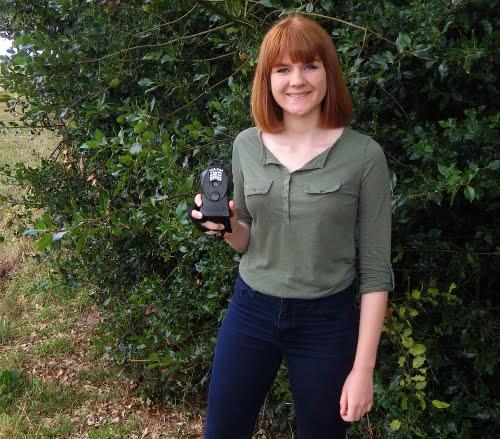
Well there have certainly been some exciting developments this month! Local wildlife enthusiast, Georgia Locock, has been helping us record some of the wildlife on the Green, by using one of her trail cameras. After a couple of attempts, we managed to get some lovely footage of a fox, which can be seen on Georgia's blog (along with loads of other fascinating and worthwhile things that she is doing). This fox seems to be in good condition although quite nervous of the camera! Undeterred, we decided to put the camera up again to see if we could get some more footage. So imagine our suprise (and delight) when we caught on camera, not just one, but two adult foxes! Clips of the footage can be seen again on Georgia's blog post. This time, they seemed a lot more relaxed around the camera and look to be in good health. We are very lucky that Georgia has offered to help us in this project, as she is experienced in using trail cameras and very knowledgable about wildlife in general. Thanks Georgia and I can't wait to find what else is on the Green!
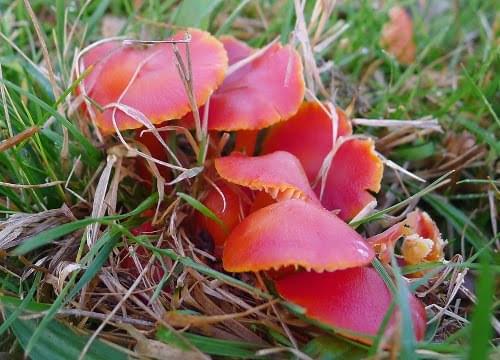
Something that is a bit easier to see and doesn't require a trail camera are the waxcap mushrooms. These delightful mushrooms can be seen on the Green in October and November and come in a whole range of colours. Waxcaps are a very important indicator species of nutrient poor meadow land, like Pipe Green, so we are always pleased to see them appear. More images of then can be seen on our facebook page
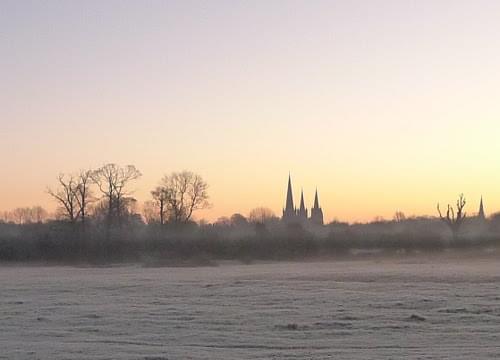
Just to finish on a wintery note - sometimes it is just worth getting up early and going for a walk on the Green!
October 2014
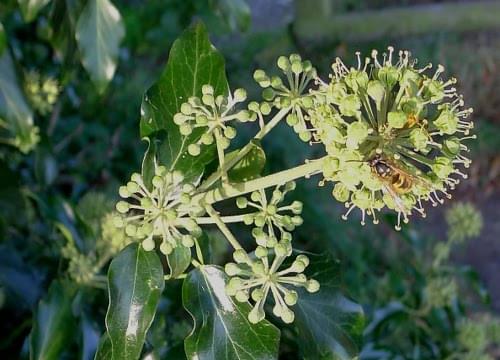
Walking onto the Green in early October, I was suprised to hear much buzzing of insects and a lovely sweet smell in the air. Closer inspection identified that a patch of ivy was flowering and was attracting a whole range of insects, including wasps and hoverflies. Whilst ivy may not look very special, it is a very important plant for wildlife. Not only does it provide nectar in late Autumn for insects, but also the berries are an important winter food source, especially for birds. Now there is a bee, that feeds exclusively on ivy nectar, aptly named the ivy bee. It only emerges this time of year, when the ivy is flowering. You may have seen a feature about this bee on Autumnwatch; it first appeared in the UK in Dorset in 2001 and is now starting to spread northwards and has now been recorded in Warwickshire and south Staffordshire. So definitely need to keep a look out for the ivy bee next year on the Green.
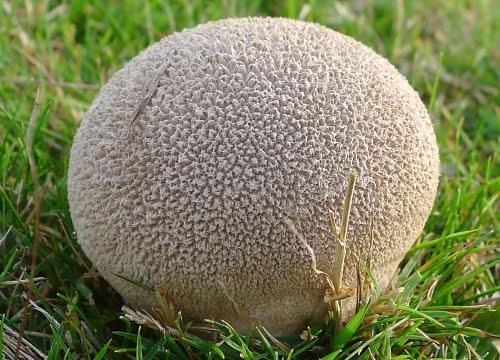
Another sign of Autumn is the appearance of toadstools and mushrooms. Pipe Green has had quite a good display of parasol mushrooms this year, but there are also a number of puffballs that are now appearing. I have never really paid this mushroom much attention, but a closer look reveals a very delicate and intricate network on the surface of the mushroom. Seemingly this surface alters as the mushroom gets older and so I thought it would be interesting to photograph some of these changes over the next few days. So imagine my annoyance, when I went back a day later to take some more photos, to find that somebody had decided to kick the puffball to smithereens!
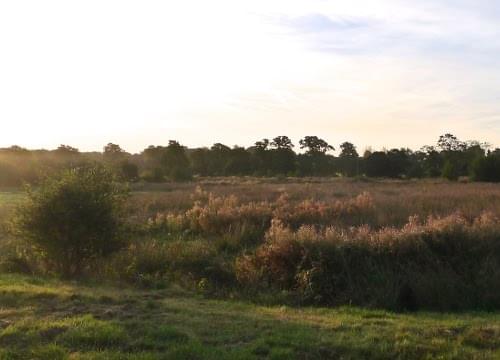
The Green does looks lovely this time of year, especially in the early morning light, just as the sun rises and everything takes on a pinkish glow. If anybody is interested in getting more involved in helping out at work parties, or just getting regular updates about the Green, then a new volunteering webpage has recently been uploaded to the website. You can fill out the form and that will enable us to get in touch with you and let you know about any work parties or any up and coming walks or talks that we may organise. We greatly appreciate your support.
September 2014
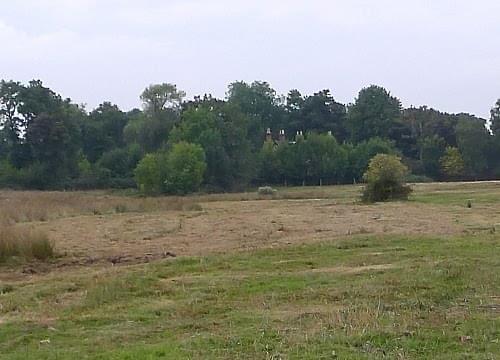
A huge thanks to Richard Robinson for cutting the Green this month with his tractor. He has managed to cut back some of the rush that was starting to encroach onto the dry part of the Green, as well as knock back any unwanted thistle, nettle and dock. He most certainly has saved us many hours with the strimmer! Cutting the Green like this, plus having the cattle grazing, keeps the grass quite short, which in turn allows the wild flowers to proliferate.
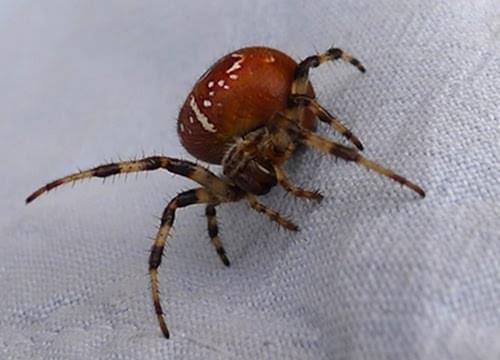
Whilst the boggier side of the Green is less well visited - for obvious reasons and even a good pair of wellies can get stuck in the mud - it does contain some interesting plants and wildlife. Anyone who has seen the Green on a frosty or dewy morning, will know that there are hundreds of spider webs suspended across the rushes. One of the most impressive are the orb spiders and whilst wandering through the rush the other day found this rather beautiful specimen on my shorts. It is, according to my book, a female four spot orb weaver spider. They do vary in colour, from yellow through to dark red and brown. Whilst they are not uncommon, I think you will agree, that they are stunning - well that is, if you like spiders.
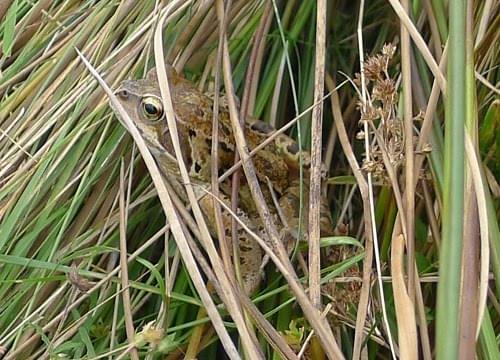
Another inhabitant of the wetter side of the green is the common frog. They are incredibly well camouflaged amongst the rush - you only really notice them when they hop across your feet! They feed on insects, slugs as well as worms but the frogs themselves are a favorite food of the heron. This was witnessed the other morning when I saw a heron successfully frog hunting on the edge of the rushes (and of course I did not have my camera with me!)
August 2014
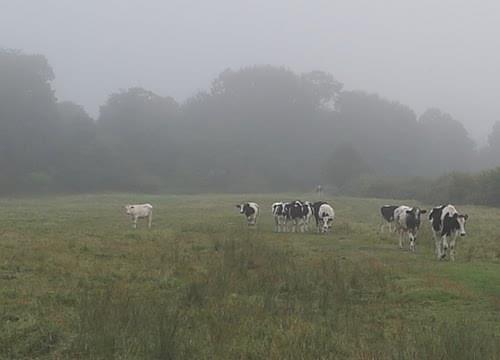
There has certainly been an Autumnal feel to the Green in the last few weeks. Not only are the blackberries ripening well, but we have also been having some early morning mists, which gives the Green a very timeless feel. In addition the parasol mushrooms are starting to appear as well as some of the puffballs - think summer might be over!
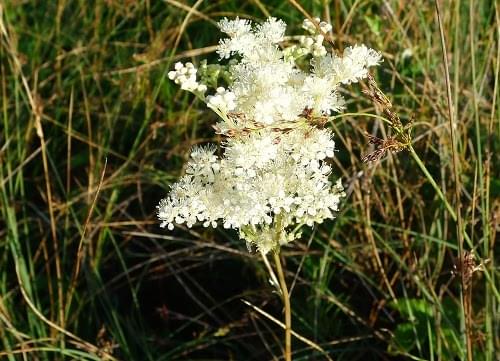
One of the plants that flowers in August is meadowsweet. This is a very delicate flower, but you will need your wellies if you want to get a close-up view! It grows by the edge of the stream and in the boggy areas of the Green. Meadow sweet is one of those plants that is surrounded by folklore and is reported to have been highly valued by the Druids. The leaves are aromatic and give off a very pleasant wholesome scent. They must have been one of the original air fresheners, as the leaves of meadowsweet have been strewn onto floors for hundreds of years, to help overcome what was probably quite a smelly room!
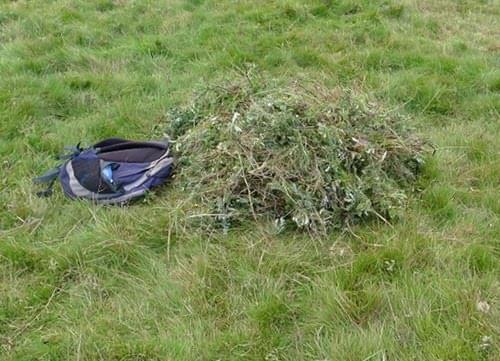
Regular visitors to the Green, will hopefully have seen that quite a lot of work has been undertaken this year to clear and control the creeping thistle. This has been done by strimming in early July and more recently by hand pulling the thistle that had started to grow back. Suprisingly thistle pulling is quite a therapeutic activity, once you "get in the zone" and it is amazing how much you can pull in just over an hour! Just have to watch out for bits of thistle getting into your finger!
July 2014
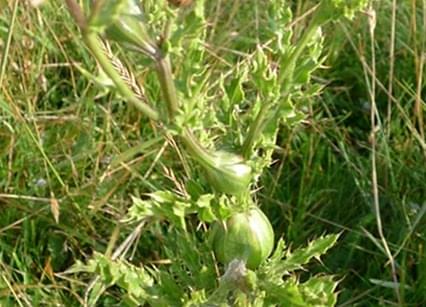
It is amazing what you can see, if you look close enough! On a recent work party we noticed that some of the creeping thistle had developed swellings or galls. I had never seen anything like this before and so sent a photo to Staffordshire Ecological Records, who confirmed that this gall contain the larvae of the thistle gall fly, Urophora cardui. This very distinctive fly lays its eggs on creeping thistle and the emerging larvae burrow into the stem of the thistle, which then causes the gall to form. What is exciting is that this is only the 6th recording of thistle galls in Staffordshire!
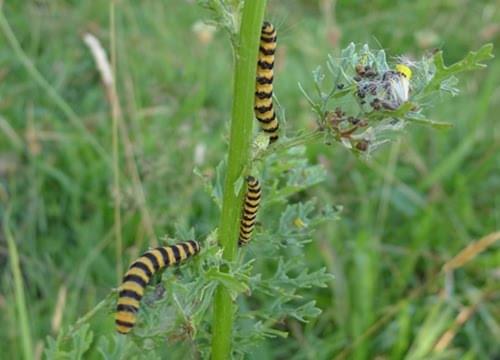
Following on with an insect theme, many of you may have noticed brightly coloured yellow and black caterpillars feeding on ragwort at this time of year. These are the larval stage of the red and black cinnabar moth. What is interesting is that the caterpillars absorb the toxic chemicals produced by the ragwort (alkaloids) and in doing so become unpalatable to any predator e.g birds. So the yellow and black colours of the caterpillar, whilst being very distinctive, are also a warning sign predators "do not eat me"! Because ragwort is toxic to cattle, we do have to remove it, each year, from the Green.
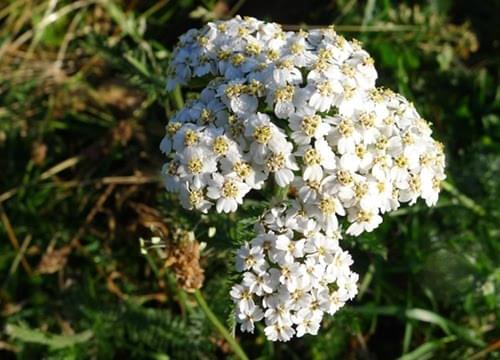
One of the plants that is flowering on the Green at the moment is yarrow. Whilst this common plant can be easily overlooked, a close up of the flower head yields some incredibly delicate structures. For anyone who is into herbal medicine then yarrow will be a very familiar plant. It has been used for thousands of years as a herbal remedy, from staunching wounds to helping with fevers and digestion. Definitely more to this plant than meets the eye!
June 2014
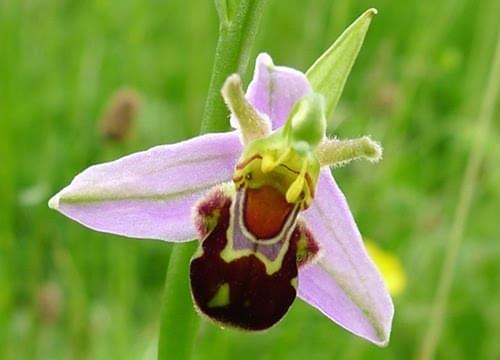
Following on from last month's post, I was very happy to find a small patch of bee orchids flowering on the Green. You would think that these plants would be very easy to spot given their amazing flowers, but I always struggle to find them as they are suprisingly well camouflaged amongst the clover and long grasses. No doubt, if you are a bee, then this is not a problem, although, ironically the bee that this flower has evolved to attract, is not found in the UK and so bee orchids rely on self-pollination.
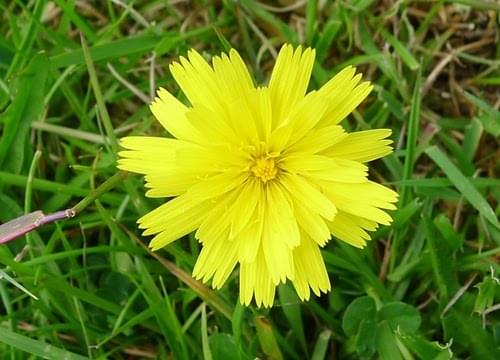
Now you might be excused for thinking that many of the yellow flowers on the Green at the moment are dandelions. Infact this is not the case and most of these "dandelions" belong to a number of closely related species known as hawkbits and hawk's beard. I have no idea why they are called this, and to the uninitiated (myself included) they are very confusing to tell apart. However, having spent some time on the Green armed with my Collins flower guide, the photo on the right is of an Autumn hawkbit (I think). There is also a Mouse ear hawkweed on the Green, which has a more lemon colour and has quite a distinctive furry leaf that, with a bit of imagination, looks like a mouse ear! So next time you are on the Green, have a closer look at these "dandelions"!
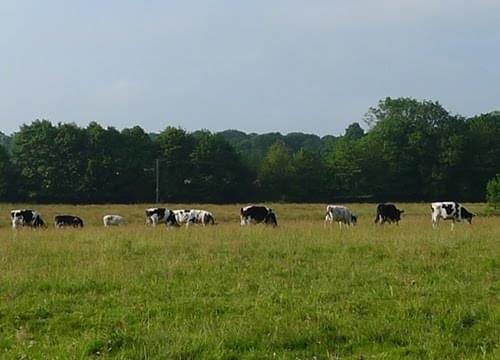
The cattle have now been on the Green for about 6 weeks and you can already see where they have grazed. Having these cattle on the Green over the summer is an important part of our management plan and they help maintain the grassland habitat. Not only do they control the growth of the grass (which in turn allows the wild flowers to proliferate), but the dung they produce is excellent for nutrients and support a bewildering array of invertebrate species. It has been recorded that in the UK, over 250 species of insects can be found in or on cattle dung!
May 2014
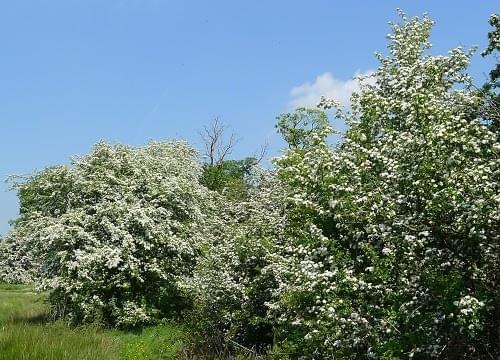
Anyone who has been on the green this last month, will know that the cattle have been turned on and are settling down well. Overall, I think the Green is looking beautiful at the moment with a wide variety of plants and trees in flower. One species that has been spectacular this year is the hawthorn, also known as the the May tree (because it flowers in May!). It is an important food source for caterpillers and moths as well as providing nectar for bees and other insects. The large amount of blossom this spring is good news for the birds, as there will be lots of berries for them in the Autumn.
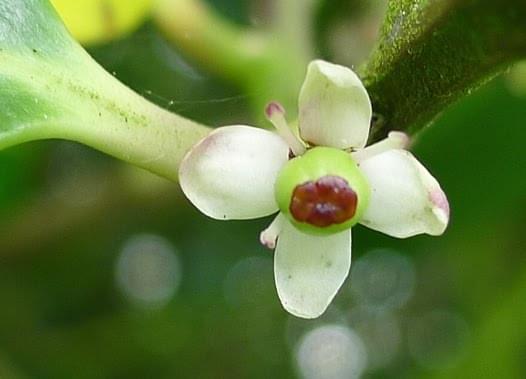
Now I am sure everyone is familiar with the bright red berries of the holly, which we use for our Christmas decorations, yet have you ever seen a holly flower? Probably not, as it is a very small inconspicuous white flower (see photo). We have some holly growing on the edge of the Green, and it took me a while to find a flower amongst all the leaves! Amazingly, holly trees only start flowering when they are about 20 years old. Holly is also interesting, as the trees can be either male or female (dioecious) and the flowers, whilst similar have different structures
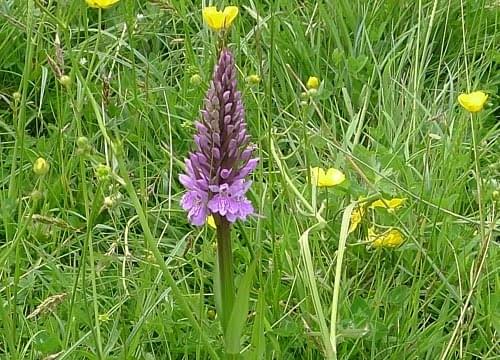
A regular flower on the Green at the moment (and one of my favourites!) is the orchid. We have a couple of patches where the common spotted orchid are flowering quite well - so go and enjoy them! We sometimes have bee orchids, but to date I have not seen any - unless the cattle have eaten them!
April 2014
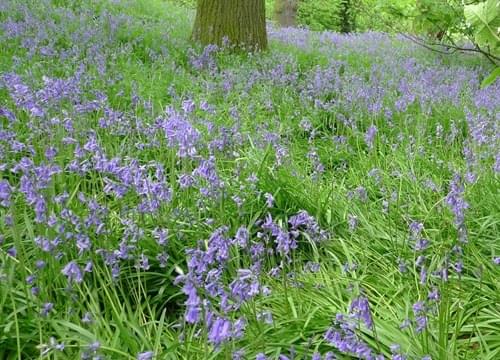
I do love this time of year! This spring seems to have been an excellent one for bluebells and there is a wonderful display of these flowers in Leomansley woods at the moment. It is well worth a visit and you will be rewarded with a lovely carpet of blue and as well as an amazing smell. However, they will soon finish flowering, so if you have not already seen them, then I would suggest you do so before the end of the week.
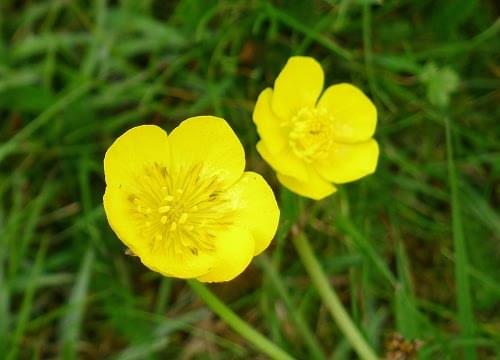
A flower that we all take for granted is that of the buttercup. This common plant grows well on the Green and enjoys some of the damper conditions that the Green has to offer. Each flower has five petals and they always have a shiny appearance. What is interesting is that some buttercups have an extra petal and the number of these 6-petaled plants can be used to roughly calculate the age of a meadow. According to studies one 6-petaled buttercup (out of a sample of 100) equates to the meadow being 7 years old. So, if you take a 100 random buttercups and 24 of them have 6-petals, then the meadow would be 200 years old! I can feel some buttercup petal counting coming on!
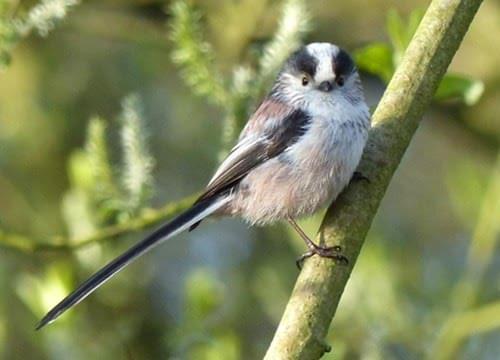
Image courtesy of Bob Russon, Lichfield & District Local RSPB Group
One of the most endearing birds found on the Green is the long tailed tit. They are very gregarious little birds and fly around in small flocks and constantly twitter to each other. They build a very elastic nest, which contains spider webs, which they weave into the nesting material. This allows the nest to expand as the chicks start to grow. The ultimate in home expansion!
March 2014
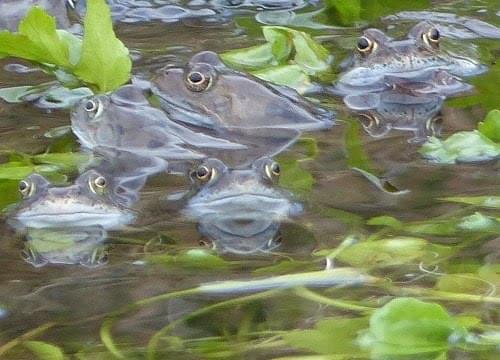
Image courtesy of Bob Russon, Lichfield & District Local RSPB Group
Well, the frogs most certainly seem to be enjoying the warmer weather! A large number of these frogs congregated in Leomansley Brook in early March and mated. Consequently there is now a large amount of frog spawn in some parts of the Brook. Hopefully some of the tadpoles will survive and develop into adult frogs. I just love their eyes!
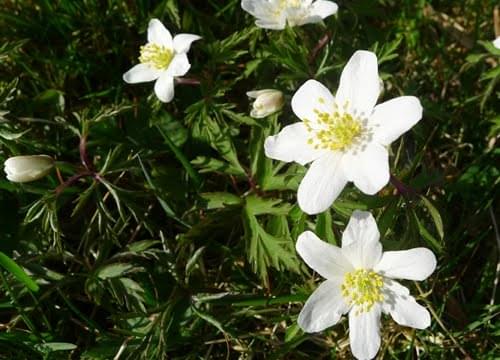
One of my favourite flowers of all time is the wood anenome or wind flower. I can't resist taking photos of these stunning delicate flowers. This year I have noticed that these plants have spread over quite a large area of the boggy part of the Green. They do like damp conditions, so all the rain and wet weather we have had obviously has suited the wood anenomes! If you want to see more of these flowers then there is quite a good display in Leomansley Woods, but the best that I know of is in Hopwas Woods. They can be found near the canal by Hopwas Wood Bridge - but you will have to get there quick as the flowers do not last that long!
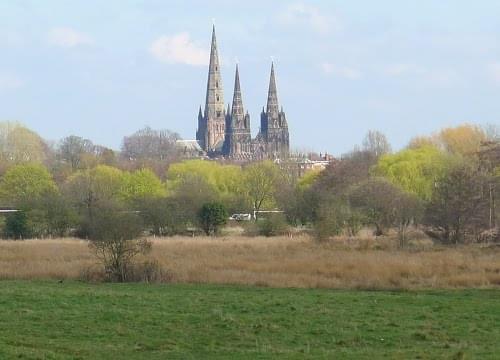
A lovely view of the cathedral from Pipe Green with the trees just starting to come into leaf. Some of the summer resident bird species have already arrived, including the chiffchaff, which can be heard calling on Pipe Green. They have a characteristic call, and are one of those birds that are easier to hear than see! Reed buntings can also be seen on the Green, often near some of the bramble bushes. We are fortunate that each year these little birds usually successfully breed.
February 2014
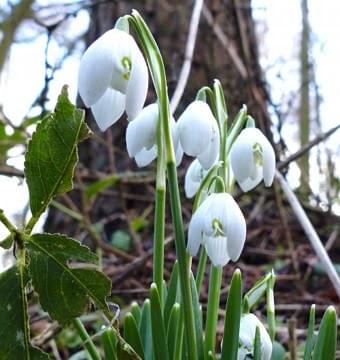
Image courtesy of Bob Russon, Lichfield & District Local RSPB Group
Spring most certainly seems to have arrived. After a horrible February, the change in weather is most welcome. The Green is starting to dry out, although you still need your wellies in certain parts and there are still some pools of standing water! The snowdrops have been lovely this year, and whilst there are only a few clumps on the edge of the Green, Bob Russon took this close up photo of some in Leomansley woods. I always marvel at the detail on the flowers. The bluebells are also starting to push through in Leomansley woods and hopefully they will put on a good display later on. There is going to be another walk of Leomansley and Pipe Green led by Kate Gomez of Lichfield Lore (and more recently Lichfield Discovered). It is going to be at the end of April and I can definitely recommend going.
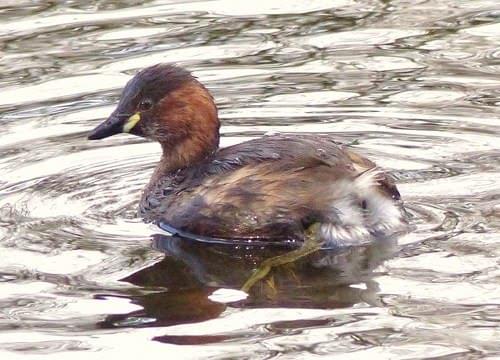
Image courtesy of Bob Russon, Lichfield & District Local RSPB Group
On the bird front, there is mixed news. After a promising start with the barn owls, they have not been seen in the nest box since the February storms - see 8th February entry on Wildlife Kate's blog . This is very disappointing, as they were becoming regular visitors to the box. Hopefully they are still around and who knows, they may still reappear! Fortunately, some of the other birds, seem to be faring quite well. The pair of little grebes are still on Leomansley ponds and so it is quite likely that they will breed this year, which is very exciting. Here you can see the little grebe starting to come into breeding plumage.
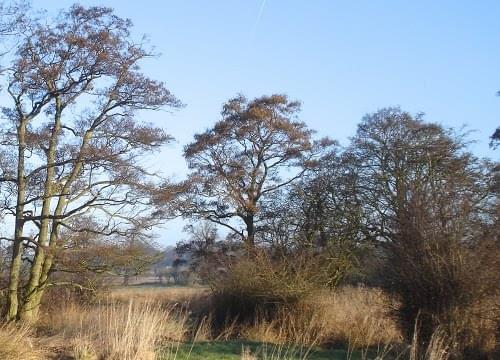
A slightly different view of the Green is from the line of alders running by the brook just above the football fields. This time of year they have a lovely purple canopy and the grey trunks take on a warm tinge in the spring sunshine. Alders grow very well in boggy areas and there are many mature specimens along Leomansley brook. The birds love their seeds and if you stop for a minute and look carefully at the trees, you may be suprised at how many birds you can see in the trees. I also saw a patch of celandine flowering on the Green yesterday - spring is definitely here!
January 2014
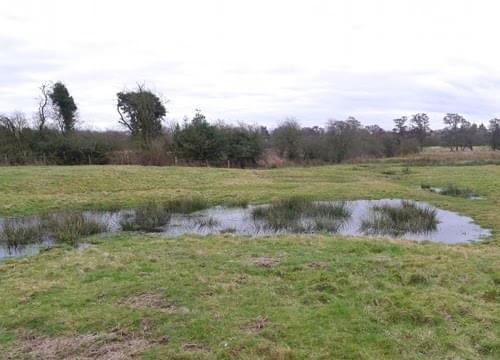
What a soggy start to 2014! There is alot of standing water on the Green, with new ponds and streams appearing daily. It has, however, been a very mild month and the snowdrops are already starting to flower! This is a month earlier than last year.
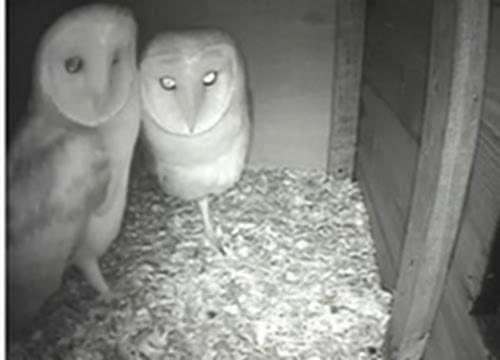
Image courtesy of Kate Macrae
Despite the grotty weather, there has been some exciting developments on the bird front. Bob Russon has already seen 43 bird species this year in and around the Green, including the little grebes on Leomansley ponds and the kingfisher. In addition we may be fortunate enough to have barn owls hunting over the Green. WildlifeKate (of Springwatch and Autumnwatch fame) has recently put up a barn owl nesting box in the vicinity of Pipe Green, which is being continually monitored with some very clever infrared cameras. As shown in this photo, she has got some amazing footage of a pair of barn owls visiting the box on a regular basis. You can follow this fascinating story on her blog page as well as live footage from the camera on her website. Barn owls generally hunt at night and may well be using Pipe Green. Maybe, when it is a bit warmer, I will venture over at dusk/early evening, to see if I can see them. Wouldn't that be amazing?!
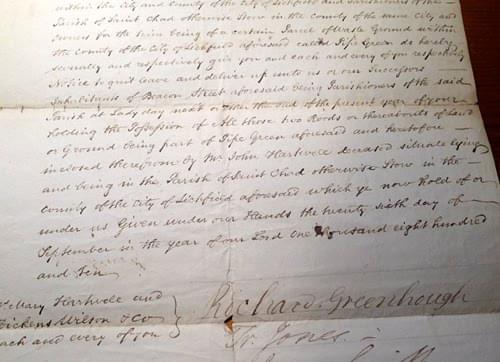
One of my New Year's resolutions was to add more information to the history part of the website. With this in mind, I have been spending quite a few hours at the Lichfield Record Office going through the Pipe Green Trust records. At present I am looking at the accounts from 1794 and gradually working my way forwards. So far I am up to 1810! I never knew accounts could be so interesting! I am starting to build up a picture of how the Green was being used, what work was being done and who were members of the Trust. With most things though, no sooner do you answer one question, but it raises another ten! I can see this is going to take me longer than I initially thought!